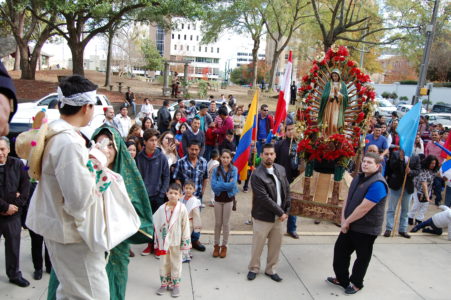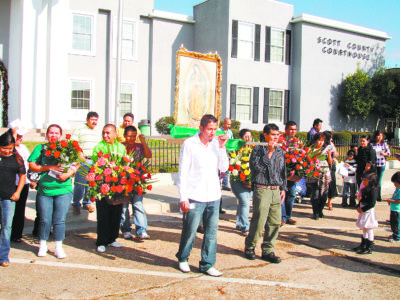By Maureen Smith
JACKSON – A good talk with your mother every day could improve your health. At least, that’s what happened for immigrants in one Mississippi community. A study out of the University of Alabama exploring the link between faith and health demonstrated that those with a devotion to Our Lady of Guadalupe had fewer negative health issues related to stress.

JACKSON– The Hispanic community at the Cathedral of St. Peter the Apostle hosts a procession downtown, like this one from 2016, for the feast of Our Lady of Guadalupe. (Photo by Elsa Baughman)
“This drives home how important faith is. In the study results I found that people who are exposed to stress – their wellbeing goes down over time. Those who were Guadalupan devotees broke that pattern,” explained Rebecca Read-Wahidi, the study’s author.
She grew up in Forest where the state’s largest concentration of Latinos work in poultry plants. They worship at St. Michael or at its mission San Martín. A community of Sisters, Guadalupan Missionaries of the Holy Spirit, ministers to the mix of Mexican, Guatamaulan and other Latin American people. The sisters teach English, host consulates and even offer workshops in what to do if people are stopped by police or immigration agents.
Constant worry about immigration raids can wear down an already poor population. Read-Wahidi was told stories of a 2012 road-block that led to the deportation of 40 people, sending a wave of fear through the rest of the community. Having a patroness, a protector and a surrogate mother helps ease that physical and mental stress.
Our Lady of Guadalupe appeared in 1531 to Juan Diego, a poor Indian and recent Christian convert. She told him she wanted him to go to the bishop and have a church built on Tepeyac Hill. The lowly Juan Diego was turned away. He told the Virgin to send someone else. When his uncle become deathly ill, Juan Diego went in search of a priest instead of returning to the bishop, trying to avoid the Virgin by walking another way around the hill. She appeared anyway, declared that Juan Diego’s uncle was already cured and sent him, again, to the bishop, telling him to take flowers as a sign. She herself tied the flowers into his cloak, or tilma. When Juan Diego unwrapped the cloak, he and the bishop were shocked to find a perfect image of the Virgin on the cloak under the flowers.
In the image, she is dark skinned, pregnant, and surrounded by stars. She stands in front of the sun’s rays, a commonly known symbol of an Aztec god, symbolically eclipsing his power as she looks lovingly down on her people. Millions of pilgrims still flock to Tepeyac to see the tilma.

FOREST – This 2012 photo shows a procession honoring Our Lady of Guadalupe from the Scott County Courthouse to St. Michael Parish. Rebecca Read-Wahidi conducted her doctoral research on the link between devotion and health in this community.(Mississippi Catholic file photo)
Read-Wahidi studied at Mississippi State University. Her Spanish studies took her to Mexico where she was exposed to the pervasive devotion to Our Lady of Guadalupe. “While I was there, I became interested in Mexican Catholicism because it was different than what I was familiar with,” she said. When she returned home, she began to see the Virgin in her own hometown.
“It is really fascinating to me because it really is a contrast in Mississippi – which is very Protestant. Here is this Mexican feast being carried out in the streets of a Mississippi town,” she said. Read-Wahidi wrote her master’s thesis about Our Lady of Guadalupe and migrant communities in Mississippi. She expanded upon her earlier thesis while studying for a doctorate in biocultural medical anthropology at the University of Alabama. “I liked going there because I could continue working with the same community,” Read-Wahidi said. “I went from (looking at) the celebration itself into how they use it to deal with stress, specifically immigration stress,” she added.
The sisters in Morton welcomed her, introducing her to the community and facilitating meetings. Read-Wahidi developed a survey to gauge the impact of their faith on their health.
Our Lady of Guadalupe is more than just a mother figure to her people, she is their mother. Read-Wahidi said most of the devotees she interviewed have conversations with her throughout the day. Sister Lourdes Gonzalez, MGSpS, who helped with the study, said Mary “listens to their worries. It’s a way to pray. People talk to her as if she is alive and in the room. She has a special place in the family.”
Father Tim Murphy, pastor at Tupelo St. James Parish calls the relationship profound and inspiring. “She is their mother in faith, in heaven and is present to them,” he said.
This connection to the poor may be why people see Mary as the perfect intersessor. “They may not feel comfortable talking to God – but they can speak to the Virgin. She is the mother figure. When they are so far from home, they need a mother figure,” Read-Wahidi said.
Father Michael McAndrew, CsSR, has been working in Hispanic ministry for many years and gives presentations on Juan Diego’s experience. “When Juan Diego does not want to go to the bishop, Mary tells him ‘am I not here? Am I not your mother? Would your mother not protect you on your journey? I am with you.’”
Read-Wahidi wrote in a journal article that immigrants place their stress in Mary’s hands. “When I asked what people petition the Virgin to help them with, they mentioned: finding work and keeping their jobs, not getting deported or arrested, the health of their family back in Mexico and here in the United States, the safety of family members who were making the journey across the border, and their own safe return back home.”
These prayers offer relief from the stress of their everyday lives. “They are seen as outsiders. They are not equal (here). They have the experience of racism, It is a way to remind themselves that in the eyes of the Virgin, all people are equal,” said Read-Wahidi. This idea has spread to other immigrants through public celebrations surrounding the feast.
Every year on or around the Dec. 12 feast day, immigrants across Mississippi leave the safety of their homes and churches to take their mother to the streets and celebrate her love and protection. Celebrations include processions, hours-long traditional Aztec dances, meals and liturgy. Everyone, especially other immigrants are welcome. In this way, the celebration in America is unique. Instead of being only a Mexican feast, it is a feast for all. “They make the celebration public – it is taken out into the streets. It gives the Mexican community a chance to share her (the Virgin). They enjoy seeing other people embrace her,” explained Read-Wahidi.
“We make processions because we know as a people we are walking in life, we are on a journey – we are walking to heaven, to God,” said Sister Gonzalez.
The celebrations are a sharp contrast to daily life for immigrants. They spend most of their lives trying to avoid attention. But for the feast, they come out in droves. Father Murphy said 300 people attended one procession in northeast Mississippi. “They will come straight from the fields. This will be the end of the sweet potato harvest so they will come with the dust still on them, but they will come and celebrate,” said Father Murphy.
“The best of liturgy does not represent, it re-presents the truth,” said Father Murphy. “This celebration is good liturgy. Who does (Our Lady of) Guadalupe appear to? The lowest of the low,” he said. Asking Mary to intercede offers a powerful conduit to Jesus since, in Our Lady of Guadalupe, “the mother of our savior is the mother of the poor.”
(See page 13 for a schedule of celebrations for this year.)
